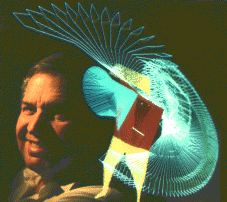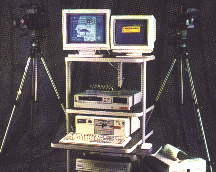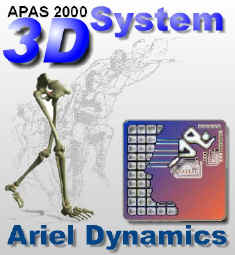The APAS Tutorials
by
Gideon Ariel, Ph.D.
"If at first you don't succeed, try reading the instructions"


The following Tutorials represent all the APAS modules. Text, Images and Video files are utilized to give the reader the best knowledge and experience in using the APAS system. Each month an additional tutorial will be published on our web site at: / , starting with the RealCap Module and sequentially progress to the Capture, Trimming, Digitizing, Transformation, Filtering, Display, Analog, EMG, Delta, Vectors and others. Then additional tutorials will be used for teaching how to analyze a performance in Sports and other human activities. It is like having a Cyber University of Biomechanics at your fingertips. Please feel free to copy the material and download the video files. Use this material in your classroom or your organization to have first hand experience with Biomechanics. Download the APAS system to any notebook or desktop and organize your curriculum to allow students to have a first class experience with this great field. You may teach also other disciplines utilizing this material. Imagine teaching Mathematics, or Biology, utilizing real life situation and use Biomechanics as the tool to teach these disciplines. Woud't children like to learn about displacement and velocity by utilizing Biomechanics to analyze the most recent Olympic events or the European Soccer Championship? The video files are large files and should be played with the MS Media Player. These video files are compressed and this why their quality is not as good for digitizing. However, it allow the teaching process to be practical within reasonable file sizes. Of course, you can create your own files and it will be great if you will share these files with others through the Internet. Capture cards becoming less and less expensive. The I-Omega 60hz capture card can be purchased for $150. You can purchase it through the Internet by linking to http://www.pricewatch.com . This site will link you World Wide to the place to buy any hardware for the least expensive price. This is amazing, when only few years ago this technology would cost Thousands of Dollars. The material will get better and better. In some cases you will find some spelling mistakes or incorrect sentences. This is due to the fact that my native language is not English. My co-workers will take care of that with time. I apologize for that. However, the material is first class and you could not get it anywhere else. I was the first one that started all this electronic Biomechanics. My publications going back to 1968 when I used a Sonar digitizer to digitize the knee joint angle and transmit the coordinates data from a modem at 300 Bauds, in my kitchen in Amherst Massachusetts, to Dartmouth College at Hanover New Hampshire. Dartmouth was the only University in the World to have a Time Sharing system. Also, the Basic Language was invented at Dartmouth College where I learned it from the inventors, Kemney and Kurtz. The original APAS System I was written it in the Basic Language.
I will appreciate any feedback and corrections. Mail your messages to: gideo@arielnet.com
Have a happy APAS
Gideon Ariel, Ph.D.
Introduction
Ariel Dynamics Inc. invented the FIRST computerized Movement Analysis System, known as the Ariel Performance Analysis System (APAS) in 1968. The System's inventor, Dr. Gideon Ariel, developed the first on line electronic digitizing system for reducing each picture in a film sequence, and later from a video, into its kinematic components. Since 1971, Ariel Performance Analysis System has assisted medical professionals, sport scientists, and athletes, to understand and analyze movement using its advanced video and computer motion measurement technology. It surpasses all other video systems for quantitative accuracy and scientific excellence for the most cost effective choice in major medical and research and educational institutions around the world.
The Ariel Performance Analysis System (APAS) is the most advanced computer-based system for the measurement, analysis, and presentation of movement performance. It is the only technology exist today to allow video as well as markers and none markers system to integrate movement and its components. The study of the motion of living things is known as "Biomechanics" and it has evolved from a fusion of the classic disciplines of anatomy, physiology, physics, and engineering. Biomechanical quantification are based on Newtonian equations and the APAS analytic technique models the human body as a mechanical system of moving segments upon which muscular, gravitational, inertial, and reaction forces are applied. Although the system has primarily been used for quantification of human activities, it has had many industrial, non-human applications. The computerized hardware/software technique provides a means to objectively quantify the dynamic components of movement and replaces mere observation and supposition.
The APAS demonstrates significant advantages over other common approaches to movement systems.
First, except for specific applications requiring EMG or kinetic (force platform) data, it is non-invasive. No wires, sensors, or markers need be attached to the subject. | |
Second, it is portable and rarely requires any modification of the performing environment. Cameras can be transported to the site and positioned so as not to interfere with the subject. | |
Third, the scale and accuracy of measurement can be set to the levels required for the activity being performed. Video equipment technology currently available is sufficiently adequate for most applications requiring accurate motion analysis and is normally the least expensive option, particularly when two or more cameras are needed. The APAS system was measured the best when was compared to all other systems. | |
| Forth, When you purchase the APAS system, you receive additional Work Stations on any number of NoteBooks or Desktop computers. This way you can "net" together all the computers to work in harmony and efficient way. Number of Universities utilizing the APAS system in the classroom, where each student has his/her own system, for no additional cost. |
The ability to record the activity as a picture has a number of advantages:
It allows the scientist to make intellectual decisions regarding the joint center at each frame rather than using markers attached at the skin's surface. However, you can use marker to do both. | |
Subsequent quantification would be possible since the video can be re-examined at any time. You never loose your raw data ! | |
Stick figure results can be overlapped with the video pictures for effective result presentations. |
Applications of the APAS usage include many areas of interest.
Sport or athletic applications have included but not limited to, volleyball, soccer, American football, tennis, track and field events, horse racing and jumping, and golf. | |
Medical research is using the APAS to quantify movement in Parkinson patients with and without drugs and before and after surgical procedures. |
Job quantification | |
task improvement, | |
post-injury assessment | |
employment evaluations | |
risk assessment, | |
worker's compensation | |
disability evaluations | |
ergonomic evaluations of job tasks | |
job standardization can be useful in the workplace. | |
Industrial applications include product design, analysis, and improvement as well as such things as manufacturing hardware performances such as piston movement accuracy. | |
Artistic endeavors, such as playing the violin, the harp, and the piano, have been examined biomechanically by APAS applications. | |
Mammalian research has examined thoroughbred race horse performance, feline locomotion, and monkey jumping performance. | |
Forensic analysis have included injuries sustained in football, gymnastics, horse racing, and running shoes. | |
Space Research have included number of research studies at NASA. | |
Rehabilitative usage include pre- and post-hip replaceme replacement functioning, gait analysis, and comparisons of bilateral functions. | |
| Educational purpose to teach students other fields through Biomechanis |
Tutorials:
The APAS System Tutorial - Introduction | |||||||||
Capturing with the JVC-9800 for the 60, 120 and 240 Hz. Digital Video Camera New !
| |||||||||
RealCap
| |||||||||
Capture | |||||||||
Trimming (Universal Trimming Program) | |||||||||
Digitizing (Automatic and Semi-Automatic)
| |||||||||
Transformation | |||||||||
Filtering | |||||||||
Display | |||||||||
Analog | |||||||||
EMG | |||||||||
Delta | |||||||||
Vectors | |||||||||
Kinetics | |||||||||
Go to Home Page]

